Birdfinding.info ⇒ Common across much of its large range, especially in the coastal plains from California to Costa Rica, around the Gulf of Mexico, the Greater Antilles, the Leeward Islands, the ABC Islands, and along the Caribbean coast of South America, where it is among the most conspicuous wading birds. In the U.S., it also breeds commonly around several interior wetland systems such the Great Salt Lake area of Utah and the Mississippi bottomlands of southern Missouri and Arkansas. (For the Hawaiian form, see “Hawaiian Stilt”.)
Black-necked Stilt
Himantopus mexicanus
The Americas from Canada to Brazil, in ponds, lagoons, and marshes with expanses of shallow water.
Two distinct forms are visually identifiable, and could potentially be classified as separate species: the widespread “Black-necked Stilt” and the “Hawaiian Stilt” (knudseni, covered separately), endemic to the southeastern Hawaiian Islands.
In North America, breeds locally in interior wetlands of the Pacific states and Great Basin north to Washington and western Montana, on the Great Plains north to central Alberta, southwestern Saskatchewan, and South Dakota, in the Mississippi Valley north to southeastern Iowa, along the Gulf of Mexico from Texas to Florida, and north along the Atlantic coast to southern New Jersey. Winters mainly along the southern tier of states from California to Florida.
In spring, overshooting migrants regularly wander north to British Columbia, Manitoba, Ontario, Quebec, the Maritime provinces, and Bermuda. Scattered pairs often breed north and east of the usual breeding range—especially in wetland areas around the Great Lakes.
In Middle America: breeds nearly throughout Mexico and very locally southward along the Pacific Coast of Central America: around the Gulf of Fonseca and Gulf of Nicoya. In winter it becomes much more numerous and widespread throughout the lowlands of Central America.

Black-necked Stilt, on nest. (Savannah Spoil Site, Jasper County, South Carolina; June 15, 2007.) © Steve Calver

North American Breeding Bird Survey Abundance Map: Black-necked Stilt. U.S. Geological Survey 2015
In the West Indies, resident essentially throughout: from Cuba and the Bahamas to the ABC Islands and Trinidad. Numbers across the region presumably swell with North American migrants during the northern winter, although this is difficult to determine.
In South America, breeds in the Pacific lowlands from southwesternmost Colombia to southern Peru, in Colombia’s Cauca Valley, in intermontane valleys of northern Peru, in the Caribbean lowlands and Llanos of Colombia and Venezuela, and in northeastern Brazil from northern Maranhão to central Bahia. Also resident in the Galápagos Islands.
Nonbreeders wander widely in the Amazon Basin and central and eastern Brazil south to the Pantanal, southern Goiás, and Rio de Janeiro. As in North America, it seems likely that some of these wanderers occasionally breed outside the normal South American breeding range.

Brazilian records from © Wikiaves
A zone of occasional or regular overlap with White-backed Stilt (H. melanurus) extends from the intermontane valleys of northern Peru across the western portion of the Amazon Basin to Rondônia, then across most of central and eastern Brazil—where both forms occur at least somewhat regularly throughout the states of Goiás, Tocantins, Minas Gerias, Bahia, Espírito Santo, and Rio de Janeiro.
Identification
Distinctive and unlikely to be mistaken for anything except another stilt: a large shorebird with a long neck, a straight or slightly upcurved, thin, black bill, extraordinarily long pink legs, and crisply contrasting black-and-white plumage.
Predominantly black on the upperparts, including the crown, the back of the neck, the wings and the mantle. The rest of its plumage is white.
The head appears about half black and half white, with black extending from the crown to eye and cheeks. A prominent white spot over the eye is usually enclosed by black, but on some individuals the white spot connects to the white forehead.
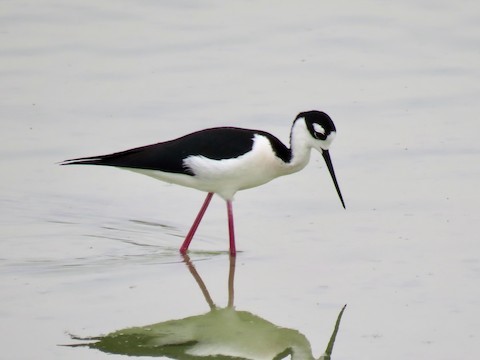
Black-necked Stilt, male. (Henderson Bird Viewing Preserve, Clark County, Nevada; April 5, 2018.) © Joe Yohannon
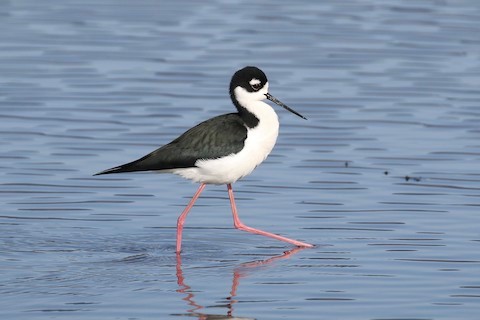
Black-necked Stilt, male showing a subtle greenish sheen on the wings. (Island City, Oregon; April 22, 2018.) © Russ Morgan
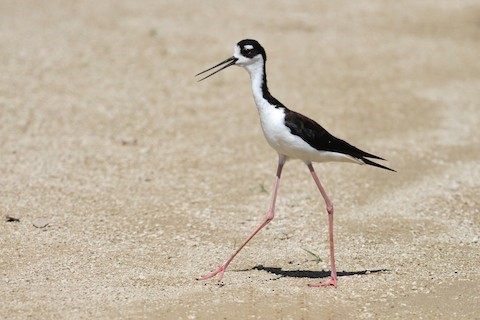
Black-necked Stilt, male. (Homestead, Florida; July 13, 2018.) © Alex Lamoreaux

Black-necked Stilt, male showing a subtle greenish sheen on the wings. (Rio Bosque Park, El Paso, Texas; May 11, 2019.) © Ad Konings
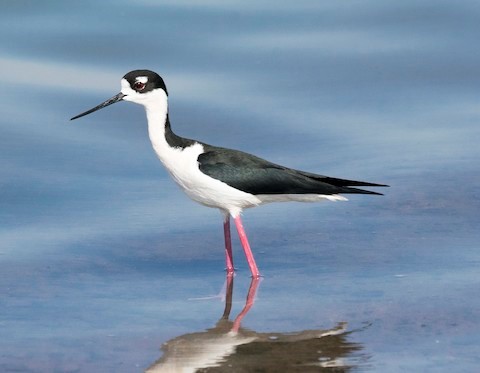
Black-necked Stilt, male showing a subtle greenish sheen on the wings. (San Diego National Wildlife Refuge, Chula Vista, California; February 11, 2018.) © Terry Hurst
Males typically appear jet-black on the upperparts, or sometimes show greenish iridescence.
When seen at close range, females and older immatures typically appear dark-brown instead of jet-black on the scapulars (i.e., most of the “back”).
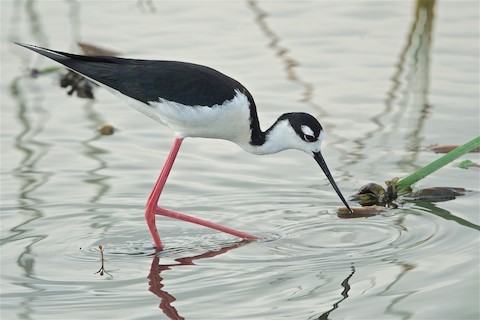
Black-necked Stilt, male. (Tyrrell Park, Beaumont, Texas; March 23, 2020.) © Harlan Stewart
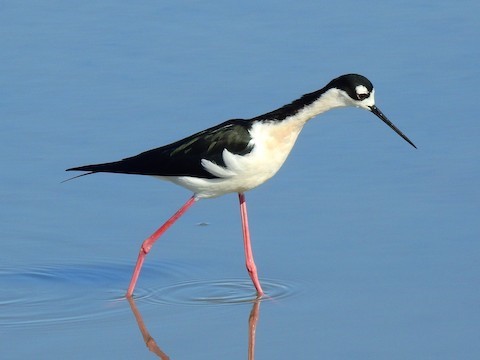
Black-necked Stilt, male showing jet-black upperparts. (Belmont Slough, Redwood City, California; February 21, 2018.) © Joshua Stacy
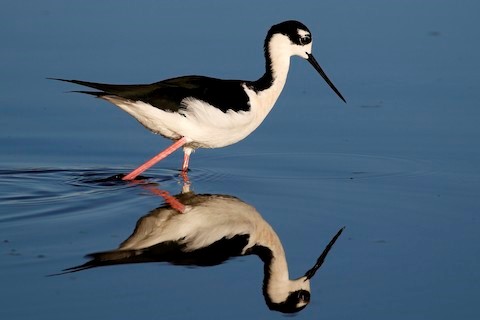
Black-necked Stilt, male. (Hazel Bazemore County Park, Corpus Christi, Texas; December 30, 2019.) © Ted Keyel
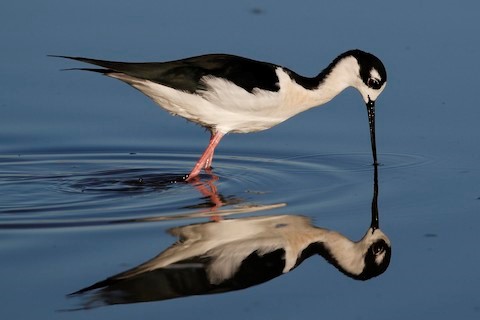
Black-necked Stilt, male. (Hazel Bazemore County Park, Corpus Christi, Texas; December 30, 2019.) © Ted Keyel

Black-necked Stilt, male at left, female at right. (San Diego National Wildlife Refuge, Chula Vista, California; February 11, 2018.) © Terry Hurst
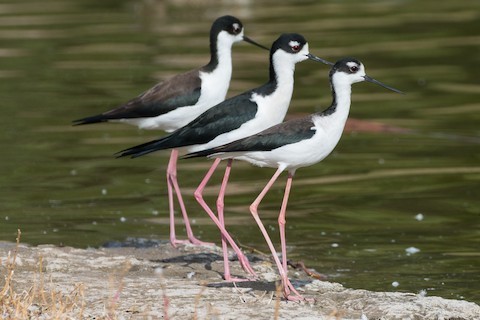
Black-necked Stilts, female, male, and immature, showing different head patterns. (Parque Tangamanga, San Luis Potosí, Mexico; December 2, 2019.) © Juan Miguel Artigas Azas
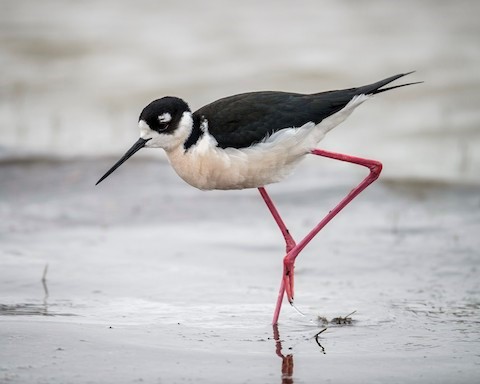
Black-necked Stilt, male showing a pinkish blush on the underparts. (Neenoshe Reservoir, Kiowa County, Colorado; April 24, 2018.) © Cameron Carver
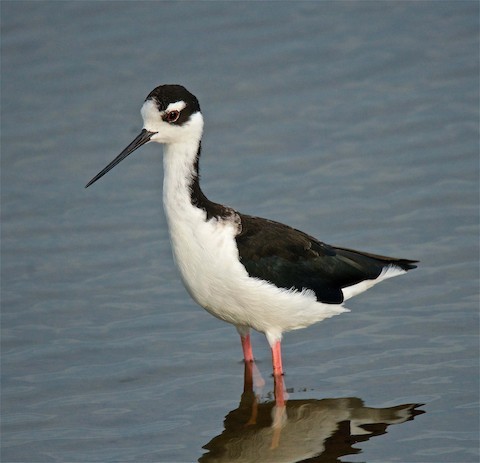
Black-necked Stilt, female or immature male—based on brownish tinge on scapulars. (Tyrrell Park, Beaumont, Texas; August 24, 2017.) © Harlan Stewart
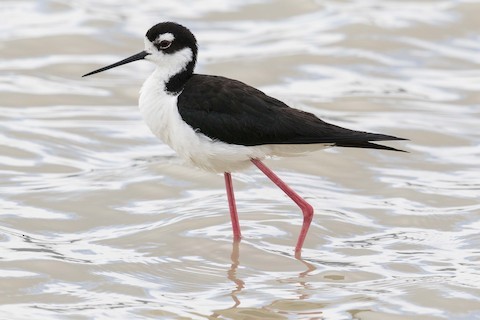
Black-necked Stilt, male. (Summer Lake, Oregon; June 9, 2018.) © Eric VanderWerf

Black-necked Stilt, male showing a subtle greenish sheen on the wings. (Tyrrell Park, Beaumont, Texas; February 14, 2019.) © Harlan Stewart
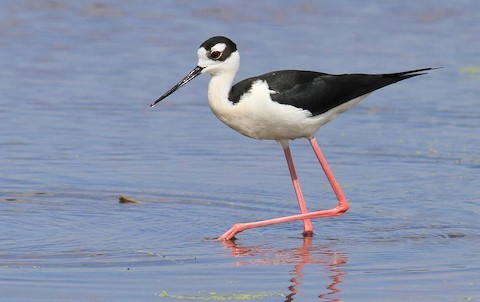
Black-necked Stilt, male with limited black on face. (The Celery Fields, Fruitville, Florida; March 14, 2015.) © Julie Gidwitz
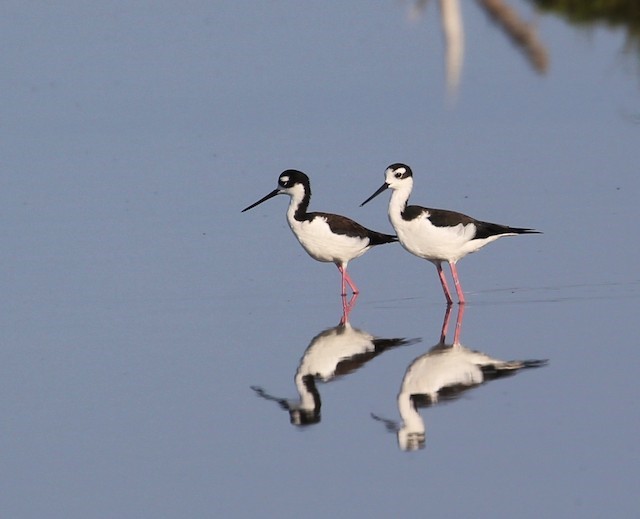
Black-necked Stilts with different head patterns—one typical and one with more white. (Santa Lucia, Camagüey, Cuba; March 18, 2018.) © Hélène Crête

Black-necked Stilt, female. (Yolo Bypass Wildlife Area, Sacramento, California; December 4, 2015.) © Matt Davis
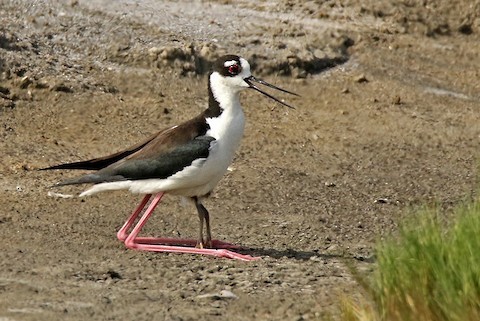
Black-necked Stilt, female engaged in distraction. (Lagunas de Ecuasal, Santa Elena, Ecuador; March 8, 2018.) © Roger Ahlman

Black-necked Stilt, female. (Tyrrell Park, Beaumont, Texas; February 21, 2020.) © Harlan Stewart
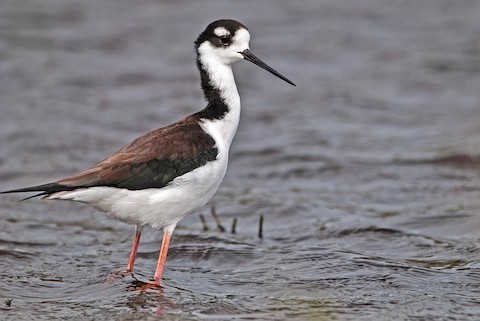
Black-necked Stilt, female—possibly immature based on extensively brown upperparts. (Myakka River State Park, Sarasota, Florida; November 13, 2019.) © Andrew Simon

Black-necked Stilt, immature female—based on extensively brown upperparts with pale fringes. (Tyrrell Park, Beaumont, Texas; February 14, 2019.) © Harlan Stewart

Black-necked Stilt, female. (Requenguela, Icapuí, Ceará, Brazil; December 28, 2019.) © Rafael Lima
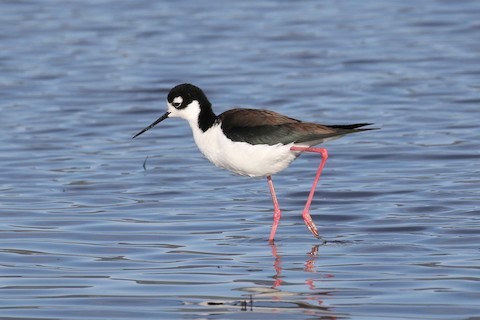
Black-necked Stilt, female. (Island City, Oregon; April 22, 2018.) © Russ Morgan

Black-necked Stilt, immature female. (Parque Tangamanga, San Luis Potosí, Mexico; January 13, 2018.) © Juan Miguel Artigas Azas

Black-necked Stilt, immature female. (Tyrrell Park, Beaumont, Texas; August 24, 2017.) © Harlan Stewart
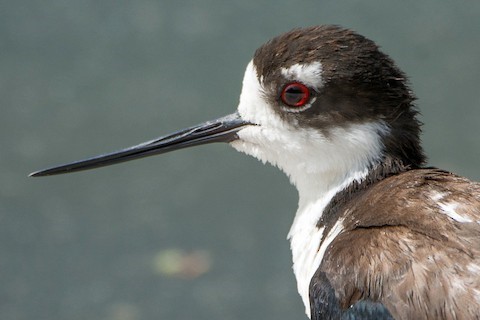
Black-necked Stilt, immature female. (Parque Tangamanga, San Luis Potosí, Mexico; June 28, 2018.) © Juan Miguel Artigas Azas
Juveniles are less crisply marked than other age classes, often whitish on the face and smudgy on the head and neck.
Their dark upperparts are variably browner and paler than on adults, with initial pale fringes on the fresh feathers making them appear scaly.

Black-necked Stilt, juvenile showing mostly whitish face and brown upperparts with pale fringes. (Lake Apopka Wildlife Drive, Apopka, Florida; June 25, 2016.) © S.K. Jones

Black-necked Stilt, juvenile—note pale fringes on upperparts. (Spaans Lagoon, Aruba; July 25, 2019.) © Michiel Oversteegen
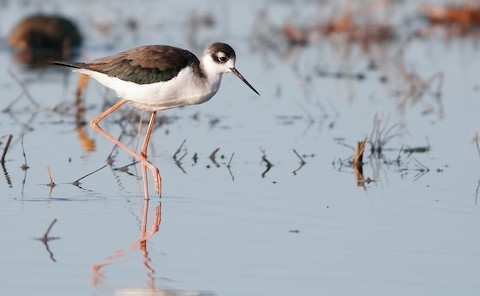
Black-necked Stilt, immature with unusually pale neck. (Lost Slough Wetlands, Cosumnes River Preserve, Sacramento County, California; October 1, 2016.) © Andrew Johnson

Black-necked Stilt, juvenile showing mostly whitish face and brown upperparts with pale fringes. (Tyrrell Park, Beaumont, Texas; July 20, 2018.) © Harlan Stewart
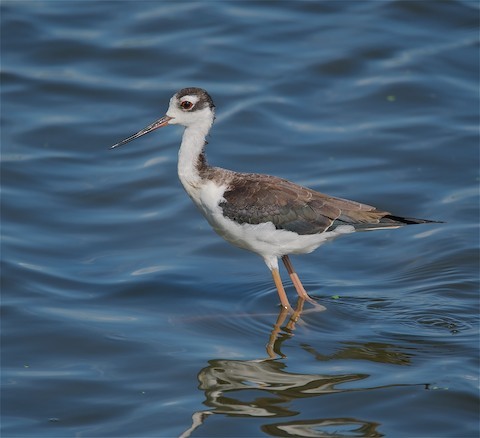
Black-necked Stilt, juvenile. (Tyrrell Park, Beaumont, Texas; August 15, 2018.) © Harlan Stewart
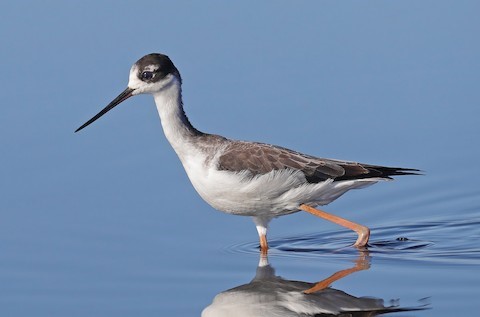
Black-necked Stilt, juvenile. (Sacramento National Wildlife Refuge, Glenn County, California; December 20, 2018.) © Matt Davis
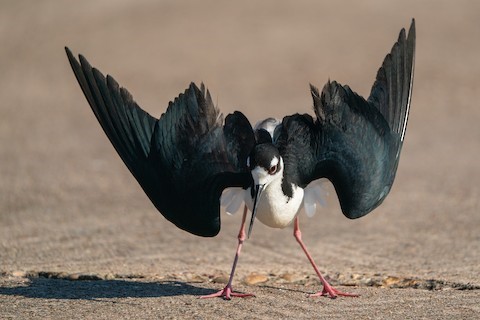
Black-necked Stilt, male in display posture showing subtle greenish sheen on black wings. (Moody Gardens, Galveston, Texas; June 14, 2020.) © Henry Jerng
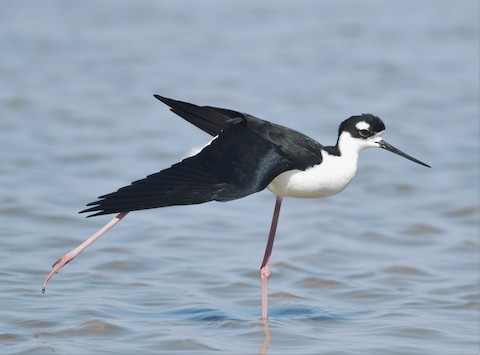
Black-necked Stilt, male showing a subtle greenish sheen on the wings. (Port Aransas Nature Preserve, Port Aransas, Texas; October 27, 2016.) © Ruth Danella
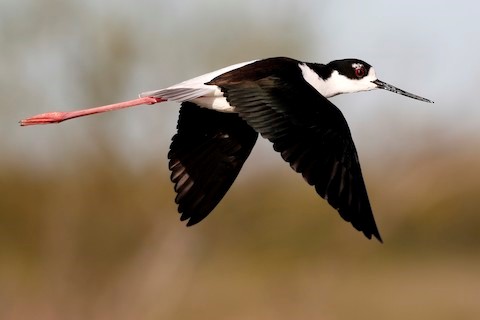
Black-necked Stilt. (Hazel Bazemore County Park, Corpus Christi, Texas; December 30, 2019.) © Ted Keyel
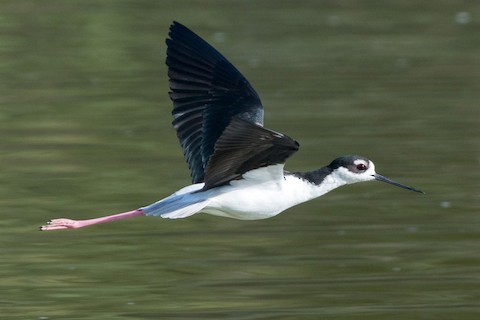
Black-necked Stilt, male showing a subtle greenish sheen on the wings. (Parque Tangamanga, San Luis Potosí, Mexico; November 30, 2019.) © Juan Miguel Artigas Azas

Black-necked Stilt. (El Charco del Ingenio Botanical Garden, Guanajuato, Mexico; January 28, 2019.) © Juan Miguel Artigas Azas

Black-necked Stilt, showing black underwing with white inner coverts—and note more extensively white face than average. (Playa de Ventanilla, El Callao, Peru; December 13, 2019.) © Lars Petersson
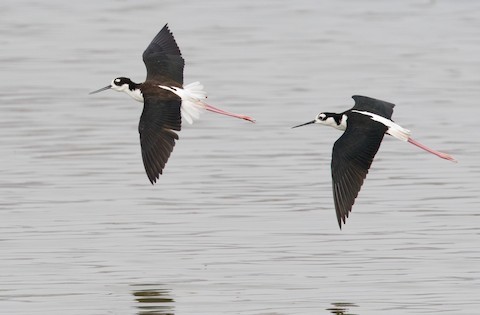
Black-necked Stilt, female at left, male at right, showing different scapular coloration and head patterns. (Playa de Ventanilla, El Callao, Peru; December 13, 2019.) © Lars Petersson

Black-necked Stilt, male. (Hillman Marsh Conservation Area, Leamington, Ontario; April 15, 2020.) © Ed McAskill
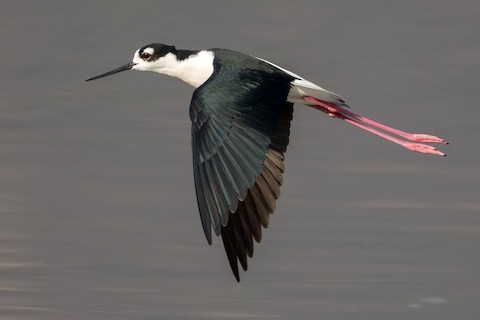
Black-necked Stilt, male showing a subtle greenish sheen on the wings. (Presa Santa Catarina, Querétaro, Mexico; March 8, 2019.) © Juan Miguel Artigas Azas
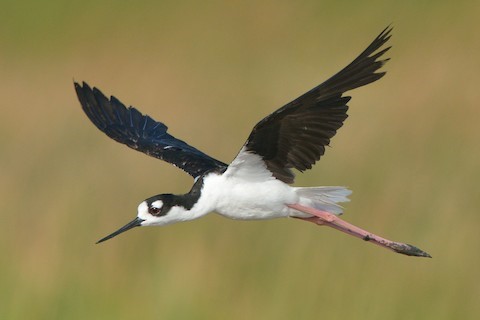
Black-necked Stilt, showing black underwing with white inner coverts. (Bubali Bird Sanctuary, Aruba; July 7, 2019.) © Michiel Oversteegen
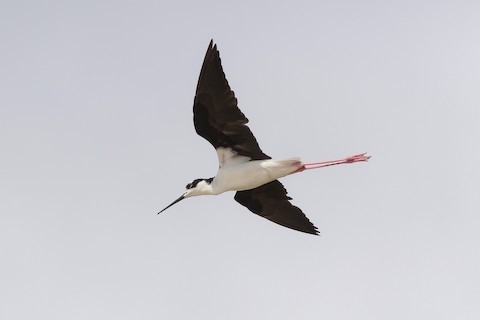
Black-necked Stilt, showing black underwing with white inner coverts. (Las Bachas Beach, Isla Santa Cruz, Galápagos, Ecuador; June 28, 2017.) © Michael O’Brien
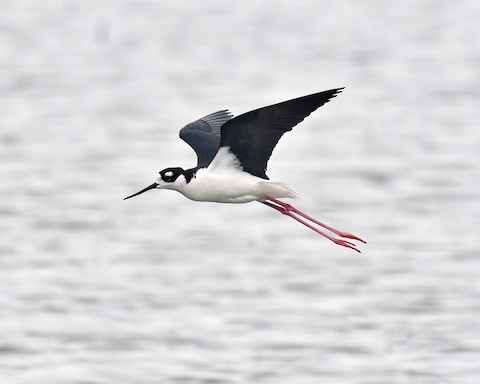
Black-necked Stilt, showing black underwing with white inner coverts. (Hillman Marsh Conservation Area, Leamington, Ontario; April 15, 2020.) © Ed McAskill
Voice. Typical calls include a sharp kek! note, repeated insistently: Sometimes relatively deep and hoarse:Sometimes thin and squeaky:
Cf. “Hawaiian Stilt”. Continental “Black-necked” and “Hawaiian” have never been known to occur together—but if they ever did it would be difficult to ascertain. They differ mainly in the extent of black on the head and neck: “Hawaiian” generally has all-black cheeks, whereas “Black-necked”’s cheeks are about 50-50 black and white. “Hawaiian” typically has a broader strip of black on the neck, covering more of the sides than on continental “Black-necked”. However, both forms vary somewhat and can overlap in these features. Possibly more definitive and objective than the black on the face and neck, “Hawaiian” consistently has a narrow black terminal band on the tail.
Cf. White-backed Stilt. Black-necked and White-backed Stilts overlap widely across South America, in a band that encompasses much of Peru and Brazil. They are often considered conspecific and have reportedly interbred in Peru (and possibly also in eastern Brazil). However, their vocalizations seem to differ consistently—White-backed has a smoother, mellower voice compared to the harsh, sharp Black-necked—and most individuals are assignable to one form or the other (with the exception of a few aberrant individuals that seem to be hybrids). So provisional recognition as separate species seems justified, although further study of breeding populations could potentially yield evidence that they function as a single species.
Adult plumages differ noticeably in two ways. Most conspicuously, White-backed has a predominantly white crown whereas Black-necked’s crown is predominantly black. This is generally sufficient to distinguish adults. Less obvious is the eponymous trait of White-backed, a white bar across the upper back which separates the black of the neck from any black on the back.
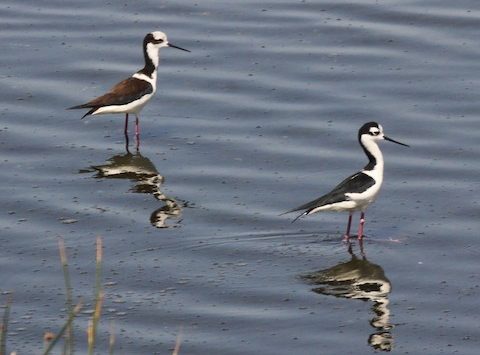
White-backed Stilt, female (left), with a male that appears to be a hybrid White-backed-Black-necked Stilt—it has a white bar across the back, but its head pattern is more consistent with Black-necked. (Humedales de Ite, Tacna, Peru; April 20, 2011.) © Larry Sirvio
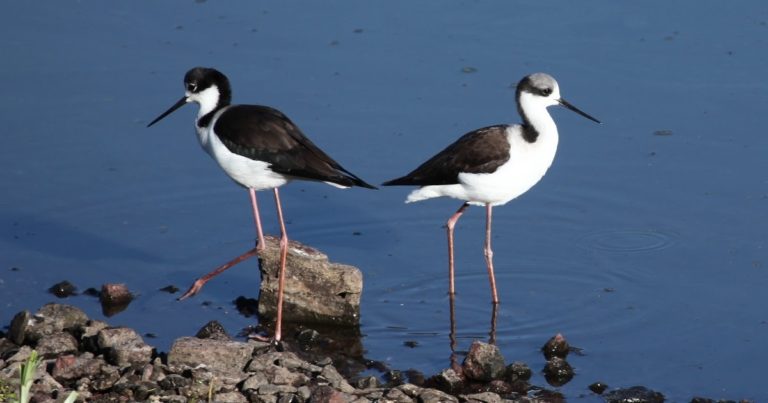
Immature White-backed Stilts—the bird on the left could be mistaken for Black-necked (and might be a hybrid), but it appears to have a white bar across its back and does not have white patch above the eye. © Marcelo Silva de Oliveira
Immatures can be more confusing, as both have a tendency to resemble the other species or form: immature Black-necked often has less extensive black (or dark-brown) on its head than adults; and immature White-backed typically has extensive black (or dark-brown) on its head—resembling Black-necked, but without the white patch over the eye. Immatures of both often have a partially pale bar across the mantle, effectively converging on an intermediate appearance.
Cf. Black-winged Stilt. In their typical plumages, Black-winged and Black-necked Stilts are readily distinguishable. However, Black-winged is highly variable and a sizeable minority of individuals have some amount of black on the head and the back of the neck. A small minority of these closely resemble Black-necked Stilt. The diagnostic difference is that Black-necked has a white patch over the eye (usually enclosed by black, although in a few individuals the white connects to the white of the forehead).

Black-winged Stilt, male with black helmet and on the back of the neck—note that this is similar to Black-necked Stilt’s typical plumage, but not identical as it lacks a white spot above the eye. (Pantani dell’Inferno, Caprolace, Lazio, Italy; March 25, 2016.) © Marco Valentini
Notes
Polytypic species consisting of two recognized subspecies that are distinct forms: mexicanus (“Black-necked”) and knudseni (“Hawaiian”). Often considered conspecific with White-backed Stilt (H. melanurus) due mainly to reported hybridization in Peru and possibly also eastern Brazil. Some authorities classify all of these forms as conspecific with the Old World Black-winged and Pied Stilts (himantopus and leucocephalus), known collectively as either Black-winged or Pied Stilt (H. himantopus).
References
Alderfer, J., and J.L. Dunn. 2014. National Geographic Complete Birds of North America (Second Edition). National Geographic Society, Washington, D.C.
Ascanio, D., G.A. Rodriguez, and R. Restall. 2017. Birds of Venezuela. Christopher Helm, London.
BirdLife International. 2019. Himantopus himantopus (amended version of 2016 assessment). The IUCN Red List of Threatened Species 2019: e.T22727969A155440465. https://dx.doi.org/10.2305/IUCN.UK.2019-3.RLTS.T22727969A155440465.en. (Accessed October 14, 2020.)
eBird. 2020. eBird: An online database of bird distribution and abundance. Cornell Lab of Ornithology, Ithaca, N.Y. http://www.ebird.org. (Accessed October 14, 2020.)
ffrench, R. 2012. A Guide to the Birds of Trinidad & Tobago (Third Edition). Cornell University Press.
Hayman, P., J. Marchant, and T. Prater. 2009. Shorebirds: An Identification Guide. Houghton Mifflin, Boston.
Howell, S.N.G., and S. Webb. 1995. A Guide to the Birds of Mexico and Northern Central America. Oxford University Press.
Kirwan, G.M., A. Levesque, M. Oberle, and C.J. Sharpe. 2019. Birds of the West Indies. Lynx Edicions, Barcelona.
McMullan, M., and T. Donegan. 2014, Field Guide to the Birds of Colombia (Second Edition). Fundación Proaves de Colombia, Bogotá.
Pratt, H.D. 1993. Enjoying Birds in Hawaii: A Birdfinding Guide to the Fiftieth State (Second Edition). Mutual Publishing, Honolulu, Hawaii.
Pyle, R.L., and P. Pyle. 2017. The Birds of the Hawaiian Islands: Occurrence, History, Distribution, and Status. Version 2 (January 1, 2017). http://hbs.bishopmuseum.org/birds/rlp-monograph/. B.P. Bishop Museum, Honolulu, Hawaii.
Raffaele, H., J. Wiley, O. Garrido, A. Keith, and J. Raffaele. 1998. A Guide to the Birds of the West Indies. Princeton University Press, Princeton, N.J.
Ridgely, R.S., and P.J. Greenfield. 2001. The Birds of Ecuador, Volume II: Field Guide. Cornell University Press.
Ridgely, R.S., and J.A. Gwynne. 1989. A Guide to the Birds of Panama (Second Edition). Princeton University Press.
Schulenberg, T.S., D.F. Stotz, D.F. Lane, J.P. O’Neill, and T.A. Parker. 2007. Birds of Peru. Princeton University Press.
van Perlo, B. 2009. A Field Guide to the Birds of Brazil. Oxford University Press.
Wells, J.V., and A.C. Wells. 2017. Birds of Aruba, Bonaire, and Curaçao. Cornell University Press.
Wikiaves. 2020. Pernilongo-de-costas-negras, https://www.wikiaves.com.br/wiki/pernilongo-de-costas-negras. (Accessed October 14, 2020.)
Xeno-Canto. 2020. Black-necked Stilt – Himantopus mexicanus. https://www.xeno-canto.org/species/Himantopus-mexicanus. (Accessed October 14, 2020.)

